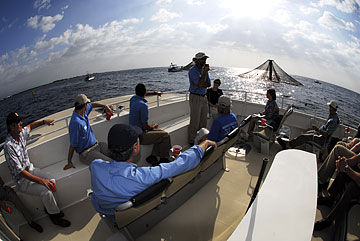
COURTESY OF KONA BLUE
After touring a fish farm in Hawaii over the weekend, U.S. Commerce Secretary Carlos M. Gutierrez said aquaculture can play a key role in helping the United States fight overfishing. Above, Gutierrez, foreground in dark hat, listened as Kona Blue Water Farms co-founder Neil Sims spoke during a tour of Kona Blue's fish pens off the Big Island. CLICK FOR LARGE
|
|
'It's a Silicon Valley of aquaculture'
A top federal official praises the progress of fish farming in Hawaii
By Karin Stanton
Associated Press
KAILUA-KONA » U.S. Commerce Secretary Carlos M. Gutierrez is praising a local open ocean fish farm for its success, adding similar aquaculture businesses would play a key role in helping the nation fight overfishing and battle a seafood trade deficit.
Gutierrez toured the Kona Blue Water Farms land-based laboratory and open ocean fish pens during a stop on the Big Island. He was in Hawaii last weekend en route to trade discussions this week in South Korea and China.
"We are watching innovation take place here," Gutierrez said. "I'm very impressed. What a future."
Kona Blue Water Farms, one of the biggest open ocean fish farms in the state, employs 40 people and ships its fish twice a week for sale to restaurants and retailers.
Founded in 2001, the company recently inked a deal to distribute to 24 stores in California, Arizona and Nevada.
Kona Blue raises 50,000 fish in each pen. It currently has five pens anchored in the 200-foot-deep ocean spread across 90 acres off the coast of Kona. A sixth pen will be added this week.
Each cage -- 100 feet tall and 80 feet wide -- represents $1.2 million in sales revenue, said Kona Blue chief executive officer Mike Wink.
The company currently only grows one variety of fish, Kona Kampachi. It's a high-value Hawaiian yellowtail known as amberjack or kahala when caught in the wild.
Gutierrez said U.S. aquaculture looks likely to become a more important industry and is a focal point of President Bush's Ocean Action Plan.
"Over 70 percent of the seafood Americans consume annually is imported and half of those imports come from foreign aquaculture operations," he said. "The U.S. annual seafood trade deficit is $8 billion."
Gutierrez also noted recent dire predictions about overfishing in the world's oceans.
"Those two things are driving us to look seriously at aquaculture," he said. "The United States needs a strong commercial fishing industry and a robust aquaculture industry to meet projected seafood demand. This is something we can compete in and win at in the future."
Hawaii is among the leading marine aquaculture locations in the United States. Experts say the Hawaii's annual fish farm sales may grow fivefold to $200 million in the next five to 10 years.
The industry will provide Hawaii with high-tech, long-term jobs, Gutierrez said.
"The people they put together here -- the marine biologists, hatcheries management, chief officers -- it seems like it's a Silicon Valley of aquaculture."
Kona Blue co-founder and president Neil Sims and the Oceanic Institute hosted Gutierrez for lunch at the company's Kona plant and took the commerce secretary on a tour of the facility, including a boat ride to offshore pens.
"It's a tremendous validation of the significance of this industry for the entire country," Sims said of the visit by a member of President Bush's Cabinet.

